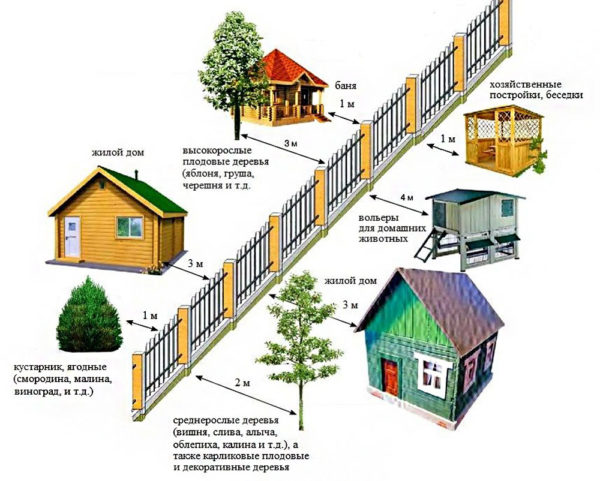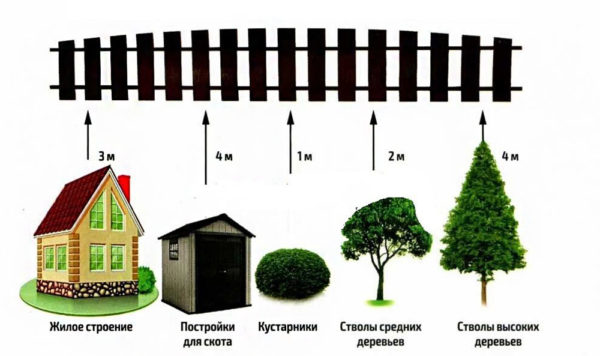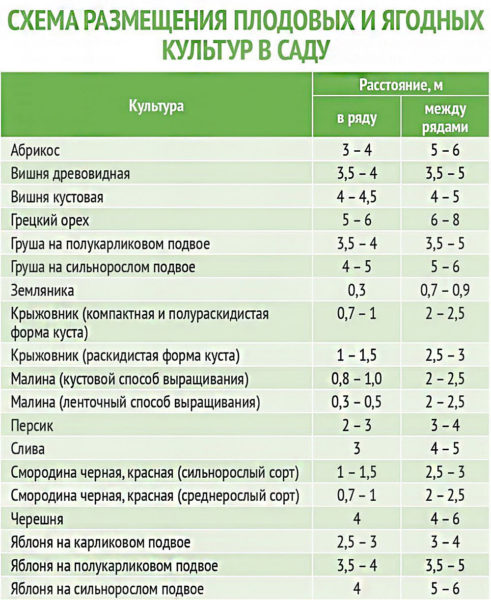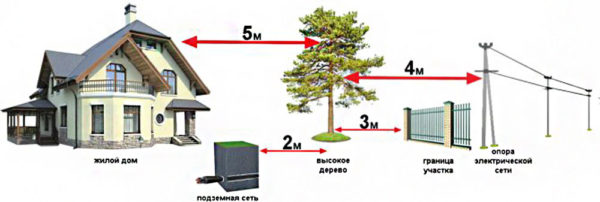Tree planting distance according to sanitary rules
Sanitary standards regulate not only construction sites, but also the location of other objects: trees, shrubs. All these are important points, the observance of which will save you from neighboring wars or even litigation. In the article, we will consider: at what distance from the house to plant trees, discuss their removal from the fence and touch on the tree planting scheme.
The content of the article
The importance of sanitary rules
Of course, no one says that you need to adhere to existing recommendations straight from centimeter to centimeter. However, if it comes to a conflict, the inspection authorities will certainly check all existing norms and their compliance in your area.
Because improperly planted trees:
- They can shade the ground floors of apartment buildings in the city. This is not allowed.
- Growing fruit or ornamental trees can easily disrupt the operation of power lines, and the root system - sewers and pipelines.
- The root system can also damage the foundation and supporting structures, as it grows underground to about the volume of the aboveground part.
- Branches growing in a neighboring area can inconvenience a neighbor with shading and foliage that is dropped in season, which will clog someone else's area.
It is clear that in order to avoid such problems, you need to take into account a certain footage when landing.
Regulations
The main document that regulates the greening of individual housing construction sites and within the city is SP 42.13330.2016. Normative documents SNiP 2.07.01-89 and SP 42.13330.2011 are already considered invalid for today.
The current SanPin is designed to ensure not only the safe living of residents of cities, towns and villages, but also to increase their own and neighboring comfort with the most dense building.
Distance from trees to fences and buildings
When planting certain green spaces, consider their height, crown volume and root system when they grow. Various literature will help with this. This approach will allow you to correctly plan the planting plan on your site and not cause discomfort to anyone.
According to sanitary rules, you need to adhere to the following standards:
- Plant trees at a distance of at least 5 meters to the nearest fence, wall of the house or running communications.
- Medium-sized crops (cherry, sweet cherry, apricot) - at a distance of 3 meters from the nearest objects.
- Shrubs - from 1.5 meters.
- Between the crops themselves, it is also necessary to maintain 3 to 6 meters to prevent wild overgrowth.
But it is important to understand another point - the existing regulations cover most of the known cases. If we are talking about a tree that grows more than 10 meters in height, forms a crown of more than 5 meters in diameter, then the distance to the nearest objects also multiplies.
And also a number of other norms are indicated there:
- Up to the axis of the trunk 5 meters - from the walls of buildings and fences;
- 3 meters from the trunk - to supporting structures, props;
- From the axis of the barrel 2 meters - to the outer edges of the cuvettes and cliffs;
- From the center of the trunk 0.7–1 meter - to the garden paths.
All norms must be observed as close as possible to the indicated figures, because in case of a negative decision of the commission, you will have to independently deal with putting the site in order.
Distance between trees
The rules also set requirements for the distance between green spaces, this allows for the full growth and development of the tree, which is especially important when it comes to exotic and expensive species.
Most often, it is recommended to use universal parameters so as not to scrupulously calculate the permissible limits for each specific type of green space. Thus, the universal distance taken as the norm when disembarking is 5 meters between each other.
For small land plots, in accordance with generally accepted recommendations, shade-tolerant trees can be planted at a distance of 2-3 meters from each other.
In addition, the compatibility rules of individual breeds must be followed. For example, when determining at what distance to plant fruit trees, you should focus on the standard of 3 meters - this will be quite enough not only for the full growth of the tree, but also for the convenience of care, processing and harvesting.
Coniferous plants can be placed at a distance of 2-4 meters from each other. And when planting shrubs near tall trees, the height of two adult plants is taken as the norm.
Distance to communications
Planting norms must be followed for several reasons. With the growth of the root system, it can damage engineering communications, the roadbed, make it difficult to carry out earthworks, damage the power poles.
Wide crowns and long branches during strong winds can lead to breaks in power supply networks and telephone cables.
Violations of the rules for planting trees can become a reason for the difficulty of passage of special equipment and fire trucks.
The standards for tree removal distances are as follows:
- The carriageway on the street or sidewalks - 1.5 - 2 meters.
- Lanterns and other lighting devices - at least 1.5 meters from the nearest branches.
- From the shaft axis at least 1.5 meters to the underground communications: gas pipeline, sewerage, water supply, power cable.
- From the center of the trunk 2 meters to the communications running above the ground: power cables, electric wires, heat pipe.
Additional requirements
There are several basic rules for high-quality and thoughtful landscaping of the site. If you follow only 3 recommendations, then you can not get any problems in the future from improperly grown crowns, an unsuccessfully distributed root system and much more.
- Most of the regulatory documents require that a distance of at least 5 meters be maintained from the wall of a residential building to a tree. But in hot southern climates, it is allowed to plant trees closer to the house in order to reduce the heating of the walls and roof in summer. In this case, the minimum distance that needs to be observed is 1.5–2 meters to the wall. This is the so-called fire distance. It is recommended to plant trees with a spreading, liquid crown, spruce or low crops up to 3-5 meters in height close to the house.
- If there are access or driveways near the house, trees are planted at a distance of at least 3 meters from the edge of the canvas, and shrubs - at least 1.5–2 meters.
- For underground utilities, it is allowed to maintain a distance of 1.5 meters from the direct line of their occurrence (must be marked with special columns). For ground communications - from 2 meters. But in order to avoid unnecessary problems, it is recommended in all cases to withstand at least 2 meters.
Also, in the process of growing trees and shrubs, it is advisable to ensure that the growing vector is correctly directed.
Disputes and ways to resolve them
Of course, the legislation provides for ways to resolve a variety of disputes related to improper landscaping and other violations of the rights of neighbors.According to it, both parties must first of all make certain efforts to independently resolve disputes. If you can't solve the issue on your own, then you will have to contact the local government.
When applying, one of the parties to the conflict provides a written statement indicating the existing problem. Local self-government bodies are obliged to respond within 10 days from the date of receipt of such a request. Conduct an examination and provide a written answer on the subject of the dispute.
In most cases, if green spaces do not meet existing standards, they will either need to be transplanted or cut down when otherwise is not possible. Responsibility for the implementation of the decision rests with the side of the conflict on whose territory the wrongly planted plantations grow.
In rare cases, when a strongly overgrown tree meets sanitary standards and all distances are maintained correctly, but part of its crown or root system passes to a neighbor's site, he has the right to saw off the crown over his territory and also get rid of some of the roots. But at their own expense and on their own.
What trees to plant behind the fence
Planting plants along the fence performs several functions: it serves as a hedge, and also decorates the landscape and protects the site from dust and extra eyes. To do this, you can choose climbing plants that create a beautiful aesthetic appearance and do not form a shadow: wild grapes, hops, clematis. In the yard near the fence, you can land:
- yew;
- fir;
- mountain ash.
From the side of the street near the fence, it is recommended to plant flowering shrubs or stunted trees:
- undersized thuja;
- lilac;
- mountain ash;
- maple;
- chestnut;
- birch.
Regardless of landscape design and composition, first of all, the requirements specified in SNiP must be observed.















